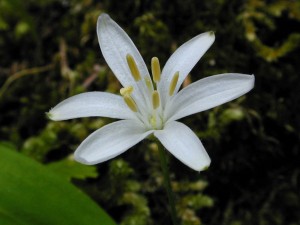Since 2009, the Lily Family has been reorganized into five families, based on genetics, rather than morphology. (See APG Changes under Resources.) As most, available, wildflower books are based on the older classification system, this website will continue to be arranged in the traditional way. However, the gallery below reflects the new system.
The following description is based on the traditional definition of the Lily Family.
There are about 250 genera in the Lily Family and more than 4000 species. They are widely distributed, especially in the temperate and tropical regions. Most lilies have bulbs or rhizomes and long, grass-like leaves, but some lilies have larger leaves that spread horizontally to catch the light and have pointy tips to let the water drip off.
Lilies are often quite showy. Members of this family have flower parts in threes; most often they have: 3 sepals and 3 petals which are usually very similar in shape, size and color and are called “tepals,” 6 stamen – 3 short and 3 long, and 3 divisions of the stigma. One exception is the False Lily-of-the Valley with parts in fours.
The fruits are capsules or berries.
Economic members of the Lily Family include: Onions, garlic, and asparagus.
Ornamentals members of the Lily Family include: Tulips, Amaryllis, Day Lilies, Easter Lilies, Hyacinths, and Hostas.
Notes: The bulbs of many of the members of this family were eaten by the Native Americans. Two species of the Lily Family are highly poisonous: Death-camas and False Hellebore.
Photo Gallery
This site features 39 members of the former Lily Family which are arranged below according to the 2009 Angiosperm Phylogeny Group organization of flowering plants. (APG Changes page.)
Amaryllidaceae – Amaryllis Family
[Not a valid template]
Asparagaceae – Asparagus Family
[Not a valid template]
Liliaceae – Lily Family
[Not a valid template]
False Hellebore Family – Melanthiaceae
[Not a valid template]
False Asphodel Family- Tofieldiaceae
[Not a valid template]

